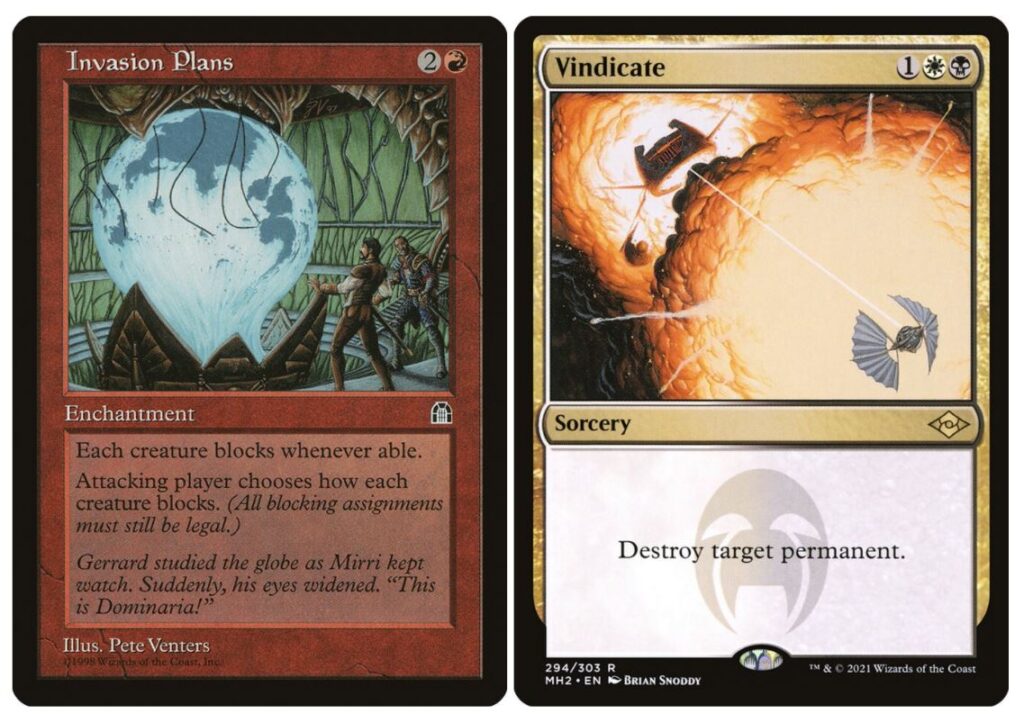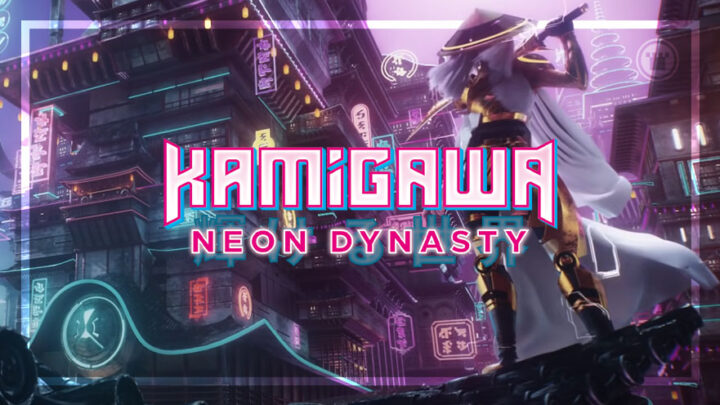If there’s one thing sure to drive Magic players into furious debate, it’s the merits of adding advanced technology to their fantasy card game. While equal parts anticipation and dread simmer in advance of the Universes Beyond: Warhammer: 40,000 Commander decks, we arguably have our first taste of clashing ideals in Kamigawa: Neon Dynasty.
Universes Beyond
In February 2021, Wizards CEO Chris Cocks announced Universes Beyond, a new class of product that “takes fan-favorite brands and brings them into Magic play systems or exciting new collectible and social play opportunities.” The first two IPs to be announced were Warhammer 40k and Lord of the Rings, the latter of which would receive a full, Modern-legal expansion. Wizards would go on to announce more future IP crossovers in their 2021 Showcase stream, including Street Fighter and Fortnite.
To say that reception has been mixed is an understatement. One of the main reasons for a lack of buy-in from longtime Magic players is that these crossover IPs just don’t feel like they fit into the Magic universe. Some players don’t want a mix of different franchises across the table from them, a la Weiss Schwarz, while others feel that science fiction and modern-day settings are at odds with Magic’s traditionally high fantasy worldbuilding.
Kamigawa: Neon Dynasty
Many of those concerns have been leveled at the latest expansion, Kamigawa: Neon Dynasty. For those unfamiliar, Kamigawa: Neon Dynasty is set in a futuristic, neo-Japan-inspired plane. Cybernetic implants, thumping beats and glowing neon are thrown into sharp contrast with traditional castles, shrines and rural vistas. The contrasting values and aesthetics highlight a world in constant motion: a battle between transience and stasis, technology and tradition.
While those who resist science-fiction in their fantasy can find refuge in the shimenawa-decorated forest shrines outside of the bustling cityscapes, it’s hard to escape the vibrant and inarguably futuristic vibe of the set.
The recent worldbuilding video – which I’ll link later on in the article – showcased some stellar artwork, but none were more divisive than a potentially Izzet-flavored DJ. Even as someone open to the idea of more modern technology and weaponry in a Magic set, I have to say I understand why, to many, this crossed a line. It’s one thing to have a DJ be present as a variety of bard, for example, but to have the analogue for a DJ be so rooted in our real-world technology and experience is reasonably jarring.
Tradition vs. Modernity
“Tradition vs. Modernity” is a familiar trope for anyone who enjoys Japanese culture, with films, literature, and anime, from Godzilla to Ghibli, that depict a nation wrestling with identity. The tension between old and new has deeper roots than 20th century media, however.
The end of the Tokugawa period and the Meiji Restoration (the late 19th and early 20th centuries) saw many traditions begin to fade from the mainstream. Japan has a complex history, and associating the adoption of Western values and the fading of tradition with the end of feudalism is a gross oversimplification. Though some aspects of cultural shift – such as the waning influence of Samurai in the military, and their subsequent rebellions – are often associated with this change in government and military evolution, the “Samurai spirit” – that is to say the values of Bushido – nevertheless persisted.
This was evident during WW2, when Japanese Officers were equipped with Shin Gunto, a modernized version of a tachi, one of the many curved blades often confused with the katana. Though swords weren’t that useful in modern warfare, the ideals of Bushido – or at least some of them – were used in military propaganda to inspire soldiers and cement patriotism in the army through the spirit of the Samurai.
This influence of traditional values on Imperialist Japan in the antebellum build up to WW2 saw a full lean into technological advancement for a nationalist agenda. Embracing technology for the sake of expansion and colonialism, the invasion of Manchuria in 1931 marks a definitive turning point in which Japan’s eagerness for resources to fuel its industrialization led to over a decade of conflict culminating in the devastation caused by the atom bombs dropped on Hiroshima and Nagasaki.
The nation’s psyche now faced an internal reckoning. Godzilla was one piece of media born from Japan’s early 20th century, processing how the hubris of human development and expansion was at direct odds with natural order and unity in the face of adversity.
Though cultural shifts herald times of intense conflict, I’d like to consider the idea that tradition and modernity are not simply oil and water – unmixable and highly flammable. Instead, I’d like to consider how they can be reconciled.
For example, while many associate the traditions of Bushido with the Samurai class, the common people of the Tokugawa period placed great importance on these values also. Though they could not know the life of the Samurai, they nonetheless adhered to Bushido values. They wove these values together with Shinto practices, Buddhist belief, and more importantly, the modern study of engineering, mathematics, and medicine. Though Japan’s industrial revolution wouldn’t truly begin until the Meiji restoration proper, the attitudes and philosophies of the population during the Edo period – Chōnindō – laid the foundations to embrace change without the need to reject tradition.
There are many ways this philosophy is evidenced in Japan’s culture through the late 20th and early 21st centuries, as diverse as embracing wabi-sabi thinking when it comes to digital design, or refashioning Omamori – traditional good luck charms commonly sold at Shinto shrines and Buddhist temples – as tech-wear accessories designed to help keep you at earth’s frequency, blocking out electromagnetic interference. The Japanese tea ceremony is perhaps the widest-spread tradition that has evolved over the years, with the opportunity to teach children human connection and consideration still highly valued – even if the ceremony itself varies by household, and the harvest of Matcha industrialized.
Science-Fantasy
Magic sets have historically been high or low fantasy by and large, with most planes adhering to the traditional medieval fantasy tropes. In recent memory, Kaladesh’s steampunk (aetherpunk) setting has so far been as industrial as it gets for many players, and so it’s difficult to imagine how IPs like Warhammer 40,000 might fit into the wider Magic multiverse.

That isn’t to say that we haven’t had science-fantasy in Magic before, though. Immediately, examples jump out in the Dominaria vs. Phyrexia-focused sets – from the hologram style globe of Invasion Plans to the infamous Star Wars-style Vindicate – but there’s more “technology” present in early Magic than you probably remember. The arbitrary divide between what’s considered fantasy and what’s considered science-fiction is in many ways a product of the Western approach to categorize mass media. And while a set like Kamigawa: Neon Dynasty or even Warhammer: 40,000 Commander decks might initially feel like mixing chalk and cheese, there’s more to what makes a Magic set feel like Magic than the initial worldbuilding.
Kamigawa: Neon Dynasty is set over 1,200 years after the events of the original Kamigawa. The landscape – both geographical and societal – has changed drastically, and while there is still much tradition to be found, the spotlight for us as consumers and Magic players is on the cyberpunk themes and technology. Building and marketing the set in this way certainly makes for a striking product, but it’s also softening us up for the future of Universes Beyond: a future where science-fantasy is more present in the Magic multiverse.
Neon Destiny
The latest Kamigawa set is full of contrasts: the lightning, the architecture, the weapons… but it’s also showing us how these contrasts can work together to create something special. In the trailer, we see what appears to be a cyberpunk Tanuki (or Tanuki mask, at least).
Tanuki are real animals, sure – a raccoon dog native to Japan – but more than that, they have a rich history in folklore. The Bake-danuki are the mischievous and supernatural analogue to the Tanuki, and persist in folklore as one of the many types of yokai (supernatural beings). As the trailer plays through, we see a shift from the more traditional yet neon lit courtyard – replete with sakura blossom – to a vast modern cityscape. Our Tanuki sits on the divide between worlds, and it’s not a stretch to imagine that this imagery is toying with the use of “golden hour” in popular media.
For a more detailed explanation of the film, there’s a great essay at filmcolossus.
2016’s Kimi no Na wa (Your Name) weaves the concept of golden hour, or Tasogare-doki (twilight hour, or dusk), into its plot. While more commonly used to denote the best time to take photographs, Tasogare-doki derives from the word Tasokare, which means “who is that”. In essence, it captures the feeling of uncertainty at dusk when it’s hard to make out faces. In Your Name, Tasogare-doki is a time when our world and the spirit world collide, and the barriers between the two are most open. The “golden” hour in Kamigawa: Neon Destiny is more like neon hour, and our Tanuki is right on the threshold.
In another revealed artwork, we see a fox-spirit – a kitsune – facing off against a Thopter. Well, that’s what you might take from the art without a closer reading, at least. Upon really diving into the art, it’s clear that the Thopter is expressing friendly happy emoji eyes, and appears to be making an offering of onigiri to the kitsune. Though quite direct, the artwork makes a statement, and a positive one at that: this clash of ideals doesn’t have to mean conflict.
While we don’t know the full narrative of Kamigawa: Neon Dynasty yet, I’m hopeful that one of the lessons it seeks to teach is that tradition and modernity can be reconciled, and that this is the perfect way to signify a tonal shift in how Magic sees itself as a wider multiverse. If anything, my hope is that tradition versus modernity isn’t the core narrative of the set, but more of a base for the flavor; a nod to what might inspire the set, a nod to the tonal shift in Magic design, but a nod that is firmly rooted in acceptance and reconciliation.
After the stellar worldbuilding panel that Wizards presented last week, I’m excited to see where Kamigawa: Neon Dynasty takes us – in this set, and beyond. I still have some reservations about how more futuristic settings and IPs will fit into the wider Magic multiverse, but I’m willing to admit that it’s way more important that a set feels like Magic than be rooted in medieval fantasy. It’s now up to Wizards to deliver.
Further Reading:
Shinto the Kami Way (Illustrated Edition) by William P. Woodard, Sokyo Ono, Sadao Sakamoto
Japan: A Modern History by James L. Mcclain
The Legends of Tono by Kunio Yanagita
Bushido: The Samurai Code of Japan by Inazo Nitobe

Kristen is Card Kingdom’s Head Writer and a member of the Commander Format Panel. Formerly a competitive Pokémon TCG grinder, she has been playing Magic since Shadows Over Innistrad, which in her opinion, was a great set to start with. When she’s not taking names with Equipment and Aggro strategies in Commander, she loves to play any form of Limited.

